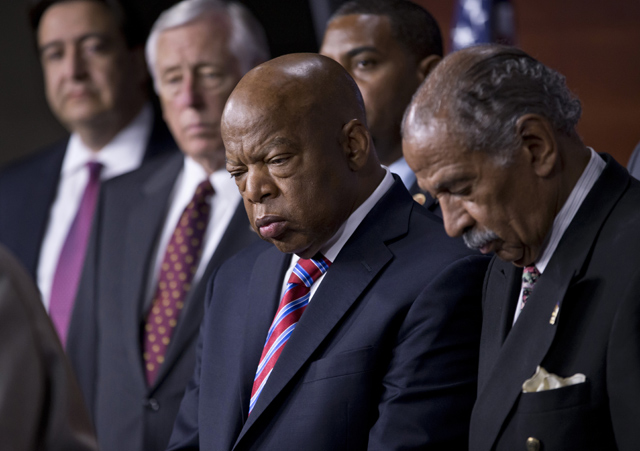This post originally appeared on Colorlines.com.

Rep. John Lewis, D-Ga., center, and Rep. John Conyers, D-Mich., right, co-chairs of the Civil Rights Taskforce of the Congressional Black Caucus, join other members of the House to express disappointment in the Supreme Court’s decision on Shelby County v. Holder that invalidates Section 4 of the Voting Rights Act, Tuesday, June 25, 2013, on Capitol Hill in Washington. Lewis, a prominent activist in the Civil Rights Movement in the 1960’s, recalled being attacked and beaten trying to help people in Mississippi to register and vote in the 1960’s. (AP Photo/J. Scott Applewhite)
The U.S. Supreme Court has ruled that Section 4 of the Voting Rights Act, which determines what states and jurisdictions are covered by Section 5, is invalid after less than 50 years of protecting African Americans and people of color. The currently covered areas are places that historically have disenfranchised people of color, or those for whom English is their second language. But Chief Justice John Roberts has ruled that the formula, which was last updated in the late 1960s-early 1970s, must be updated by Congress so that it covers areas that violate voting rights today. Chief Roberts, who’s had a beef with the Voting Rights Act since the early 1980s, wrote in the majority opinion:
“In assessing the ‘current need’ for a preclearance system treating States differently from one another today, history since 1965 cannot be ignored. The Fifteenth Amendment is not designed to punish for the past; its purpose is to ensure a better future. To serve that purpose, Congress—if it is to divide the States—must identify those jurisdictions to be singled out on a basis that makes sense in light of current conditions. … Congress did not use that record to fashion a coverage formula grounded in current conditions. It instead re-enacted a formula based on 40-year-old facts having no logical relation to the present day.”
This is not a total loss for the Voting Rights Act. Section Five can still stand if Congress is able to fix the formula so that it covers areas they consider presently running afoul of voting rights.
Meanwhile, here are the currently covered states this ruling now affects:
-
- North Carolina: Republicans, who control both state legislative chambers and the governor’s office, have proposed and/or passed bills that would require a narrow set of photo identification cards to vote, that would cut early voting, potentially penalize the parents of college students who vote away from their parents’ home, and would implement probably the strictest felony disenfranchisement law in the nation. None of these are law, but they would have had to pass federal preclearance review under Section 5. Almost 500,000 North Carolinians lack the ID needed to vote under the proposed law, a third of them African Americans. Hundreds of North Carolina citizens have been arrested over the past couple months while protesting these laws.
-
- Virginia: Passed a voter ID bill that survived federal preclearance review last year, but then doubled down and passed an even stricter photo voter ID law this year, which had not yet been submitted for Section 5 review. Now it doesn’t need to. Meanwhile, it’s estimated up to 870,000 Virginians lack the ID needed to vote under the new law, a disproportionate number of whom are African Americans.
-
- Alabama: Passed a photo voter ID law and a proof-of-citizenship voter registration law in 2011 that isn’t scheduled to go into effect until 2014. It had been submitted for Section 5 review, but was withdrawn a month ago. Now it won’t be reviewed for discriminatory effects.
- Mississippi: No African American has won a statewide office in this state (nor in any of the states above except Virginia) and a voter ID bill it passed last year may make it harder for black candidates to get elected when those most likely to be disenfranchised by this law are African Americans.
Other states like Texas and South Carolina, which Section 5 reviews blocked from passing racially discriminatory voting laws, could attempt to reinstate those laws. But as Justin Levitt, an election law professor at Loyola Law School, told Colorlines, it’s not just the states we need to be worried about.
“One of the most important pieces of Section 5 is that it prevents local efforts to discriminate in the allocation of local political power: districts for city council and county commission and local judicial offices that really affect the responsiveness of representation and justice in local democracies, in all of the kitchen-table issues that affect our lives most tangibly,” said Levitt. “When Texas passes a discriminatory statewide law, there are lots of voices in the fight, but when a tiny municipality in southwest Texas does the same, it gets a lot less attention.”
Civil rights groups that have fought both for the Voting Rights Act to be created, and to defend it in the decades after have expressed disappointment. Before the Supreme Court’s ruling, Natasha Korgaonkar, assistant counsel for the NAACP Legal Defense & Educational Fund, Inc., the entity that argued the case, told Colorlines that they were “optimistic” that Section 5 would be upheld, and if not that Congress would have to “step in.”
Meanwhile, Jotaka Eaddy, senior director of NAACP’s voting rights program told Colorlines that the Court’s decision “will not change our game plan.” Judith Browne Dianis, co-director of the civil rights law organization Advancement Project, called the decision “a huge loss” and that “the biggest harm is to the voters.” Her organization’s work would not be deterred though, she said.
“We will have to continue to do what we did in 2012 and bring our own affirmative cases,” said Browne-Dianis. “We really will have to step up our efforts to do more affirmative litigation, which is a problem because the federal government has been an important player in stopping discrimination before it happens,” through the Voting Rights Act.
Advancement Project and the NAACP have been embroiled in the civil rights struggle against North Carolina’s proposed voter suppression laws. Browne-Dianis said that this decision “could hasten the changes that are being proposed in North Carolina to make it harder to vote.”
In Texas, where the state filed its own challenge to Section 5 with the Supreme Court, Christina Sanders, state director of the Texas League of Young Voters Education Fund, said, “This [case] shows us that it is important, now more than ever, to educate our neighbors and communities about building local power to ensure that all votes are protected.”
In Florida, where voter waiting lines for African Americans were the longest in the nation, laws that cut early voting were blocked by Section 5 challenges. Election law professor Dan Smith, of University of Florida, said that challenges to discriminatory laws, like the cuts to early voting that disproportionally impacted black voters, would be more difficult without Section 5.
“We’re only talking about five counties out of 67,” that are covered by Section 5 in Florida. “But when you have [Section Five] as a vehicle you can challenge the entire state law because of the uniform election code. With respect to the voting rights issues in Florida it has been a major piece of legislation that has protected the rights of minorities and I fear for that leverage to be pulled away from voting rights activists.”
Myrna Perez, deputy director of the Brennan Center for Justice’s Democracy Program, and co-author of their recent report “If Section 5 Falls: New Voting Implications,” told Colorlines that they will be working with a coalition of voters, advocates and members of Congress to come up with new measures “that provide robust and ample protections for voters.”
 |
Brentin Mockis a New Orleans-based journalist who serves as Colorlines.com’s Reporting Fellow on Voting Rights, covering the challenges presented by new voter ID laws, suppression of voter registration drives, and other attempts to limit electoral power of people of color. In his previous position as senior editor at The Loop 21, Brentin also covered electoral politics with a significant amount of reporting on voter ID issues. Follow him on Twitter at @bmockaveli, and Colorlines at @colorlines. |

